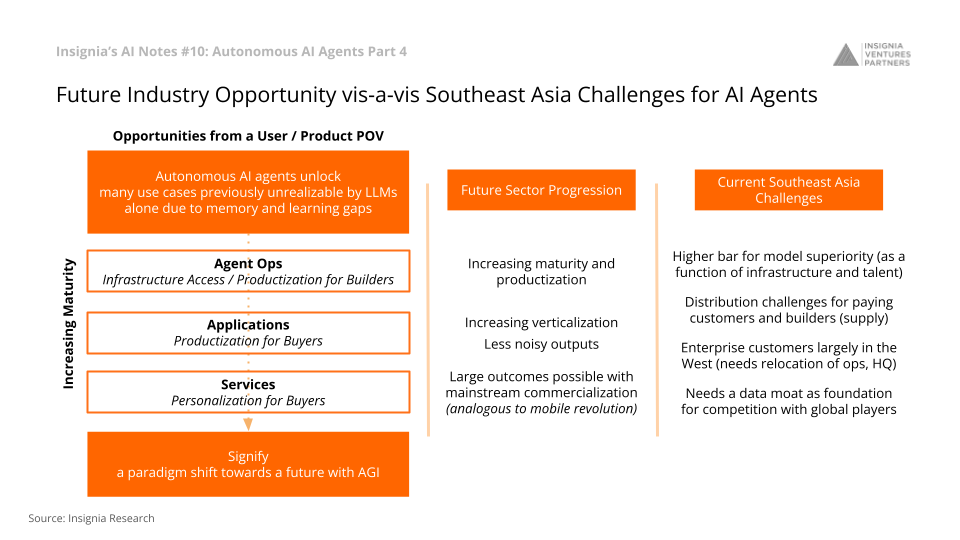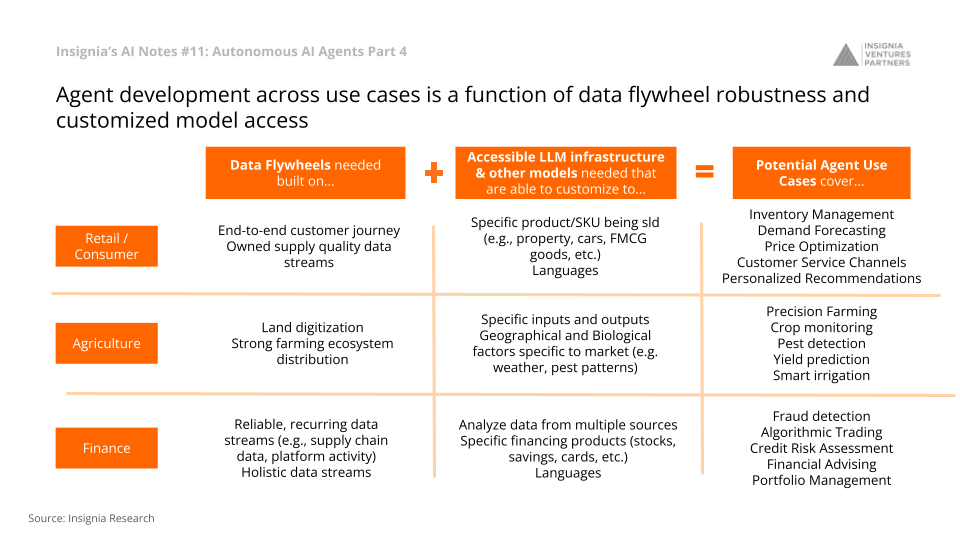In this final part of our exploration of Autonomous AI Agents, we map out the long road to building and maturing Autonomous AI Agents especially in Southeast Asia, and where some tech companies stand on this road.
Catchup on our past articles on Autonomous AI Agents:
- Part 1: How do Autonomous AI Agents work and why are they so important today
- Part 2: What is the role of AgentOps in this industry?
- Part 3: How are Autonomous AI Agents shaping up to be the apps of the future?
Future Industry Opportunity vis-a-vis Southeast Asia Challenges for AI Agents
Future Sector Progression
The horizon for Autonomous AI Agents is wide-ranging and full of potential. As these agents mature, we’ll see an increase in their productization—Agent Ops—bringing with it a slew of applications and services tailored for different industries. This evolution could be likened to the mobile revolution that forever changed how we interact with technology.
Current Southeast Asia Challenges
However, the path in Southeast Asia isn’t without its obstacles. The region faces a higher bar for model superiority, owing largely to limitations in infrastructure and access to top-tier AI talent. Additionally, the distribution of products faces challenges, not just in attracting paying customers but also in the supply of builders and innovators. Enterprise customers, who could potentially drive large-scale adoption, are often based in the West, necessitating a shift in operational headquarters. Lastly, building a data moat is crucial for standing toe-to-toe with global players in AI.

Future Industry Opportunity vis-a-vis Southeast Asia Challenges for AI Agents
Agent Development Across Use Cases: Data and Customization
AI Agents in Retail/Consumer
Data Flywheels: Building these in the retail sector requires a comprehensive understanding of the end-to-end customer journey and an internal data stream that ensures quality.
Model Customization: Technologies should be adaptable enough to account for the specific SKU, languages, and even the very nature of the products being sold.
Use Cases: These range from inventory management to personalized recommendations.
AI Agents in Agriculture
Data Flywheels: Here, land digitization and a robust farming ecosystem are crucial.
Model Customization: Considerations include weather patterns, soil quality, and other geographical and biological factors specific to each market.
Use Cases: From smart irrigation systems to yield prediction models, the applications are extensive.
AI Agents in Finance
Data Flywheels: Reliability is key, with data streams that include not just user activity but also larger economic markers.
Model Customization: The models should be capable of analyzing a wide variety of data, and be customizable to different financial products and languages.
Use Cases: These can range from fraud detection to portfolio management.

Agent development across use cases is a function of data flywheel robustness and customized model access
The Data Arms Race and the Model Chasm on the way to Autonomous AI Agents
Companies that have already begun utilizing data flywheels have a distinct advantage, as seen in industries ranging from automotive with Carro, to agriculture with Elevarm. This ‘data advantage’ is key for data-driven product-led growth and Distribution. Companies like WIZ.AI and bluesheets are closing the “model chasm” by fine-tuning their AI models for enterprise-level tasks, which could be a catalyst for mass commercialization.
As we eye the future of Autonomous AI Agents, especially in the Southeast Asia context, the road is long but promising. Companies are actively working to navigate challenges tied to data, customization, and enterprise adoption. This is not just an evolution; it’s a revolution in the making—one that will change how industries operate, potentially on a global scale.
Follow our LinkedIn page for the latest updates on our weekly AI insights and other insights in Southeast Asia’s innovation landscape.
Author’s Note: This article was written with insights and research from our investment team. Reach out to them if you’re building in this space out of Southeast Asia and would like a deeper conversation.

Follow us on LinkedIn for more AI insights every Wednesday
Paulo Joquiño is a writer and content producer for tech companies, and co-author of the book Navigating ASEANnovation. He is currently Editor of Insignia Business Review, the official publication of Insignia Ventures Partners, and senior content strategist for the venture capital firm, where he started right after graduation. As a university student, he took up multiple work opportunities in content and marketing for startups in Asia. These included interning as an associate at G3 Partners, a Seoul-based marketing agency for tech startups, running tech community engagements at coworking space and business community, ASPACE Philippines, and interning at workspace marketplace FlySpaces. He graduated with a BS Management Engineering at Ateneo de Manila University in 2019.